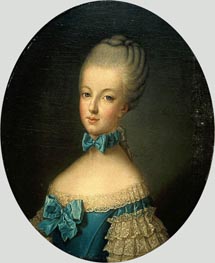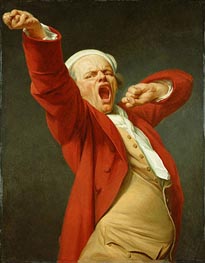
Joseph Ducreux Giclée Fine Art Prints
1735-1802
French Rococo Painter
Joseph Ducreux occupies a singular position in the constellation of eighteenth-century French portraiture, a painter whose career trajectory illuminates the complex negotiations between artistic innovation and courtly convention. Born in Nancy on 26 June 1735, Ducreux emerged from provincial origins to navigate the treacherous waters of pre-revolutionary French court culture, ultimately surviving the Terror to reinvent himself in the new social order.
His early training, possibly under his father's tutelage, gave way to a more significant apprenticeship when he arrived in Paris in 1760. As the sole pupil of Maurice Quentin de La Tour, the celebrated pastelist, Ducreux inherited not merely technical proficiency but an understanding of portraiture as psychological investigation. The influence of Jean-Baptiste Greuze on his oil technique suggests a painter actively synthesizing diverse artistic currents, refusing the limitations of a single master's influence.
The pivotal commission of 1769 - his journey to Vienna to capture Marie Antoinette's likeness before her departure to France - established Ducreux's fortunes while revealing the precarious nature of artistic success under the ancien régime. His appointment as premier peintre de la reine and elevation to the baronage represented both triumph and transgression; he had circumvented the Royal Academy's jealously guarded hierarchies, a body that since 1648 had monopolized such prestigious appointments. This outsider status, paradoxically secured through royal favor, would inform his subsequent artistic choices.
The Revolution's upheaval sent Ducreux to London, where he executed what history would record as Louis XVI's final portrait. This poignant commission encapsulates the artist's peculiar position - intimate witness to power's dissolution, yet sufficiently adaptable to survive regime change. His return to Paris in 1793 and association with Jacques-Louis David demonstrated remarkable political dexterity, transforming from court painter to republican artist without apparent ideological strain.
Ducreux's residence became a nexus for cultural exchange, attracting musicians and artists including Étienne Méhul, whose operatic characterization allegedly drew inspiration from the painter himself. This salon culture reflects a broader shift in artistic patronage, from courtly commission to bourgeois sociability. His legacy extended through his children - Jules, whose military career ended at Jemappes, Rose-Adélaïde, and Antoinette-Clémence, all painters - suggesting art as familial inheritance transcending gender boundaries.
Yet Ducreux's enduring significance lies in his experimental self-portraits of the 1780s and 1790s, works that challenge portraiture's conventional restraints. The yawning self-portrait (c. 1783) and the mocking Portrait de l'artiste sous les traits d'un moqueur (c. 1793) deploy physiognomic theory not as scientific doctrine but as license for expressive expansion. These works, alongside Le Discret with its gesture of enforced silence, anticipate photography's candid capture while harking back to Dutch tronies and Franz Xaver Messerschmidt's character heads.
His death on 24 July 1802, struck by apoplexy while walking from Paris to Saint-Denis, seems almost theatrical in its abruptness. Ducreux's career arc - from provincial beginnings through royal favor to republican reinvention - mirrors the epoch's violent transformations. His portraits, particularly those unconventional self-representations, persist as documents of an artist negotiating between social expectation and individual expression, between the mask of propriety and the face beneath.
His early training, possibly under his father's tutelage, gave way to a more significant apprenticeship when he arrived in Paris in 1760. As the sole pupil of Maurice Quentin de La Tour, the celebrated pastelist, Ducreux inherited not merely technical proficiency but an understanding of portraiture as psychological investigation. The influence of Jean-Baptiste Greuze on his oil technique suggests a painter actively synthesizing diverse artistic currents, refusing the limitations of a single master's influence.
The pivotal commission of 1769 - his journey to Vienna to capture Marie Antoinette's likeness before her departure to France - established Ducreux's fortunes while revealing the precarious nature of artistic success under the ancien régime. His appointment as premier peintre de la reine and elevation to the baronage represented both triumph and transgression; he had circumvented the Royal Academy's jealously guarded hierarchies, a body that since 1648 had monopolized such prestigious appointments. This outsider status, paradoxically secured through royal favor, would inform his subsequent artistic choices.
The Revolution's upheaval sent Ducreux to London, where he executed what history would record as Louis XVI's final portrait. This poignant commission encapsulates the artist's peculiar position - intimate witness to power's dissolution, yet sufficiently adaptable to survive regime change. His return to Paris in 1793 and association with Jacques-Louis David demonstrated remarkable political dexterity, transforming from court painter to republican artist without apparent ideological strain.
Ducreux's residence became a nexus for cultural exchange, attracting musicians and artists including Étienne Méhul, whose operatic characterization allegedly drew inspiration from the painter himself. This salon culture reflects a broader shift in artistic patronage, from courtly commission to bourgeois sociability. His legacy extended through his children - Jules, whose military career ended at Jemappes, Rose-Adélaïde, and Antoinette-Clémence, all painters - suggesting art as familial inheritance transcending gender boundaries.
Yet Ducreux's enduring significance lies in his experimental self-portraits of the 1780s and 1790s, works that challenge portraiture's conventional restraints. The yawning self-portrait (c. 1783) and the mocking Portrait de l'artiste sous les traits d'un moqueur (c. 1793) deploy physiognomic theory not as scientific doctrine but as license for expressive expansion. These works, alongside Le Discret with its gesture of enforced silence, anticipate photography's candid capture while harking back to Dutch tronies and Franz Xaver Messerschmidt's character heads.
His death on 24 July 1802, struck by apoplexy while walking from Paris to Saint-Denis, seems almost theatrical in its abruptness. Ducreux's career arc - from provincial beginnings through royal favor to republican reinvention - mirrors the epoch's violent transformations. His portraits, particularly those unconventional self-representations, persist as documents of an artist negotiating between social expectation and individual expression, between the mask of propriety and the face beneath.
2 Joseph Ducreux Artworks

Giclée Canvas Print
$76.77
$76.77
SKU: 4323-DUJ
Joseph Ducreux
Original Size:64.5 x 53.3 cm
Boston Museum of Fine Arts, Massachusetts, USA
Joseph Ducreux
Original Size:64.5 x 53.3 cm
Boston Museum of Fine Arts, Massachusetts, USA

Giclée Canvas Print
$71.65
$71.65
SKU: 4324-DUJ
Joseph Ducreux
Original Size:117.8 x 90.8 cm
J. Paul Getty Museum, Los Angeles, USA
Joseph Ducreux
Original Size:117.8 x 90.8 cm
J. Paul Getty Museum, Los Angeles, USA